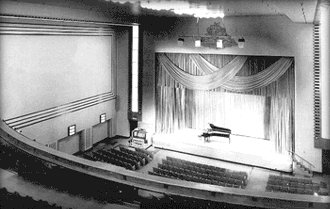


Designed as the flagship store of the Eaton empire, the seven-storey Eaton’s College Park building opened at 444 Yonge Street, at the corner of College Street, on 30 October 1930. Originally designed to be a 36-storey skyscraper, the building was scaled back to just seven floors due to the effects of the Great Depression. The French architect Jacques Carlu (1890-1976) was hired to design the seventh floor of the building (and also, at the same time, the top floor restaurant for the Eaton store in Montreal). Carlu was Professor of Advanced Design at M.I.T. at the time, and had earlier worked on projects in Calgary and Ottawa. He is credited with introducing the ‘ocean liner’ style to Canada that was a forerunner of the streamlined Art Deco style (known as Style moderne in French) prevalent in the 1930s.
The Seventh Floor, as it was known, included a huge foyer, the Eaton Auditorium (with 1200 seats, 800 on the main floor and 400 in the balcony), and two smaller rooms, the Round Room Restaurant and the Clipper Room. Eaton Auditorium was officially opened on 26 March 1931 with a recital by the Australian soprano Florence Austral, along with her husband, the flutist John Amadio. Also featured in this opening concert was Ernest MacMillan, who provided a number of solos to demonstrate the auditorium’s fine Casavant organ. The auditorium featured ‘walls of pale gold fabricoid, bird’s eye maple panelling and lighting set between bands of ebonized wood’ and its acoustics were ‘as excellent as those of Massey Hall.’1 Unfortunately, after the auditorium was renovated in 1951, its acoustics were found to be less than ideal.
Eaton Auditorium hosted numerous important musical events between 1931 and its closure in 1977. It was home to the Women’s Musical Club of Toronto for over 30 years, and saw performances by the National Ballet of Canada (its first event, in 1951), the Royal Conservatory Opera School, and the Eaton Operatic Society (even though there was no orchestra pit). Glenn Gould made his public solo debuts there as an organist (12 December 1945) and also as a pianist (20 October 1947) and he continued to make recordings there even after the auditorium was closed to the public in 1977. Dozens of distinguished international musicians performed in Eaton Auditorium over the years, among them Marian Anderson, Duke Ellington, Sergei Rachmaninoff, Paul Robeson, Elisabeth Schwarzkopf, and Ravi Shankar.
When Eaton’s moved its flagship store four blocks south to the Eaton Centre in 1977, College Park continued to have shops, restaurants and offices but the Seventh Floor was boarded up. The building changed hands several times, from A.E. LePage to London Life, and finally Great West Life Realty, the current owner. After ten years of lobbying by The Friends of Eaton Auditorium, led by Eleanor Koldofsky, the auditorium was declared to be a heritage site in 1986.
In 2002 two Toronto developers, Jeffry Roick and Mark Robert, obtained a 30-year lease and spent $8.5 million restoring the Seventh Floor to its original splendour. All that is missing is the Casvant organ, which was removed in 1977 and was later sold to First Baptist Church in Dallas. The Carlu, as the Seventh Floor is now known, officially reopened after 26 years of inactivity with a black-tie event on 3 May 2003. It remains to be seen, however, whether musical events will feature as prominently in The Carlu’s future as they have in its past.